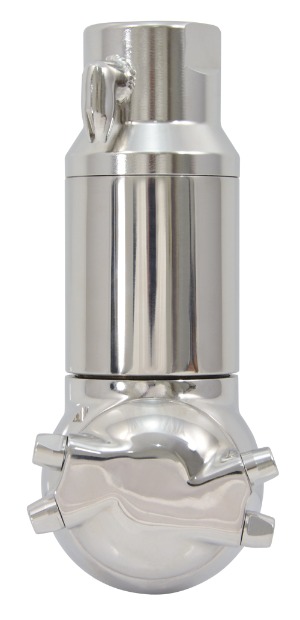One of the UK’s leading household products manufacturers was looking for a solution to clean a number of powdered detergent processing tanks as well as tanks used for storage of the product. The light residue left by the powder became sticky when in contact with the cleaning fluid, so a medium-impact cleaning solution was needed. The client was also looking to achieve a reasonably fast cycle time and a reduction in fluid consumption.

THE PROBLEM
All the tanks were relatively small at 2 x 2 m, and the processing tanks had mixing paddles in the middle which could potentially prevent a complete clean. There was 6 bar pressure available.
The client had experience of Orbitor Eco cleaning heads for some of its other tanks and wanted a rotary jet solution. SNP advised that an ATEX-certified cleaning system was necessary due to the potentially flammable nature of the dusty residue left by the detergent powder.
While fluid-driven rotary cleaners do not have any electrical components, they must still have an ATEX approval that corresponds to the class of environment they are to be used in where there is an explosion risk—in this case because of flammable dust. This is because of the potential, however unlikely, for the moving parts of the cleaning machines to create a spark or discharge which could act to ignite the dust.
CHALLENGES
- Powdery residue posed an explosion risk
- Residue became sticky once wet, so a medium-impact cleaning solution was needed
- Solution must reduce water consumption
- Solution must ensure that parts of the tank were not missed due to shadowing caused by mixing paddles
THE SOLUTION

SNP proposed the use of the Orbitor Compact rotary jet cleaner, which is one of the very few tank cleaning heads with ATEX certification for all zones and temperatures.
Rotary jet cleaners, or impingement cleaners, bring high-powered cleaning jets to bear on each part of a tank. As the water jets hit the tank walls, they explode outwards, dislodging residues by mechanical action. This use of mechanical force via a water jet is far more energy-efficient than other methods of tank cleaning, meaning that rotary jet cleaners are the most water-efficient tank cleaners available.
The Orbitor Compact rotates on two axes and has four cleaning jets. As these jets rotate, they move through a set cleaning pattern that will, over a set period of time (the cleaning cycle), ensure that jets are brought to bear on each part of the tank. This results in a very powerful and efficient clean.
Due to shadowing created by the paddles, two Orbitor Compacts were installed in each of the processing tanks, while only one was needed in the storage tanks. The 4 x 3 mm model was recommended.
RESULTS
The client had previously ordered Orbitor Eco machines and was very pleased with their performance and their very short cleaning cycle. However, due to the very fast spin speed of the Eco model’s gears, these machines are not ATEX certified, so were not an option.
While the cycle time of the ATEX-certified Orbitor Compact is longer, the model recommended still had a very quick cycle of just 13 minutes and cut water consumption to 834.6 litres of fluid, equivalent to 64.2 litres per minute.
The customer was delighted with the Orbitor Compact machine and the balance it provided between water consumption and cycle time while still being safe to operate in the ATEX zone.
ORBITOR COMPACT – CLEANING IN PLACE (CIP) – ROTARY JET
Benefits:
- Powerful cleaning jets up to 8.6 m
- Cycle times from 9.5–22 minutes
- Pressure: 4–12 bar
- Flow rate: 48.3–198 l/min
- Available as ATEX certified
- Suitable for food and pharmaceutical applications
- Due to its small size, can fit into a 100 mm opening, making it suitable for even very small tanks
Find out more about the Orbitor Compact here.
For more details on CIP in ATEX zone click here.